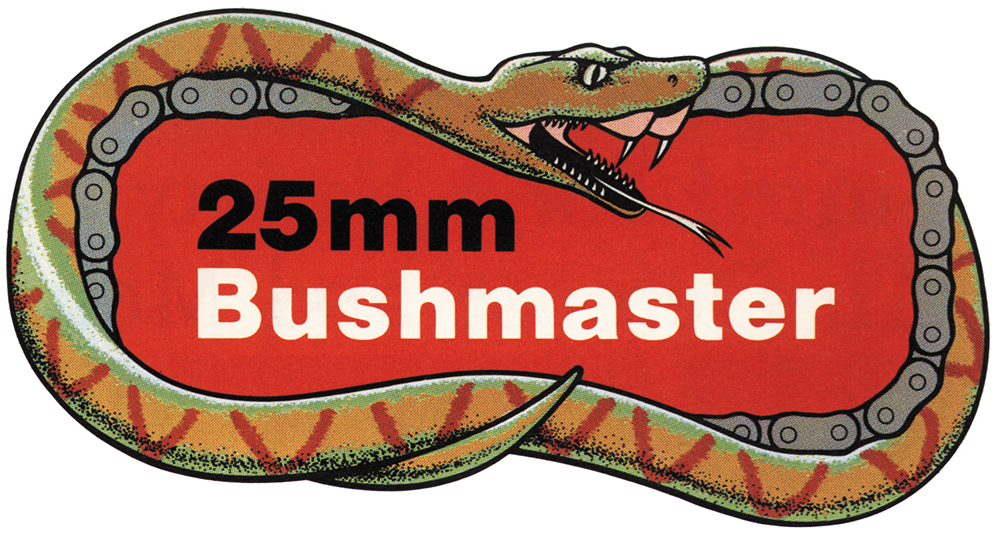By Robert Bruce
Designed in the early 1970’s by engineers at Hughes Helicopters, cannon-caliber BUSHMASTER CHAIN GUNS on the Apache Attack Helicopter, the Bradley Fighting Vehicle, and many other platforms have proven in combat to be without equal in the world. With Hughes having been successively merged with McDonnell Douglas and now Boeing, more than 10,000 of the 30mm M230 and the 25mm M242 are in service in the US and allied nations, enjoying an unsurpassed reputation for reliability, accuracy and operational effectiveness.
Concepts Compared
Typically, large caliber automatic cannon suffer from any number of problems that must be addressed by tradeoffs in design. Self-powered guns utilize by-products from firing the ammunition to operate all functions including feed, locking, extraction, and ejection. This means that their parts must be relatively heavy and resistant to extreme stress. Also, even small variations in the ammunition can lead to stoppages.
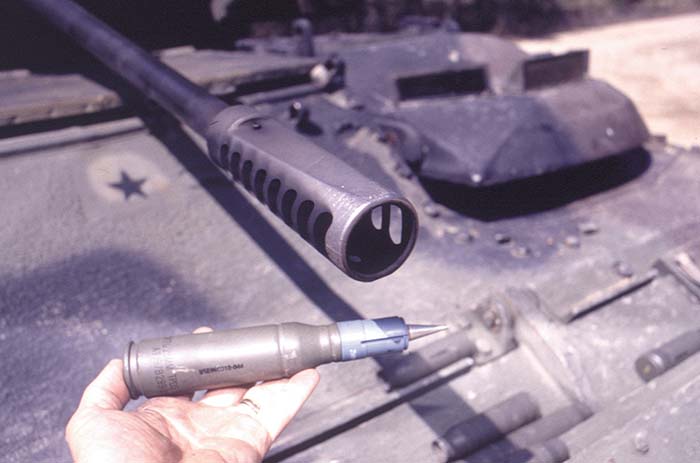
Gatling-type weapons utilize external power, usually electric motors or hydraulic systems, to rotate a cluster of barrels into firing position. While this can promote greater reliability and high rates of fire, the penalties tend to be an increase in complexity and maintenance difficulties, a high system weight and bulk, plus a greater cost.
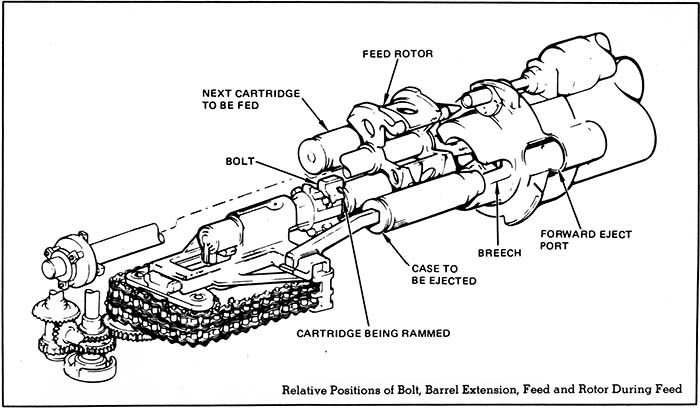
In contrast, Hughes engineers offered their single barrel, rotating bolt, electrically driven “Chain Gun,” so called because of its motorcycle type sprocket and chain operating mechanism. Not unlike an automobile engine’s timing chain, the Hughes system provides unparalleled precision, smoothness and positive action to all phases of the cycle of operation.
Anyone who has been frustrated by the process of separately adjusting headspace and timing on a Browning .50 cal should appreciate how simple and “idiot proof” the Chain Gun is. Each movement from feed to ejection takes place at exactly the right time with no fuss and bother.
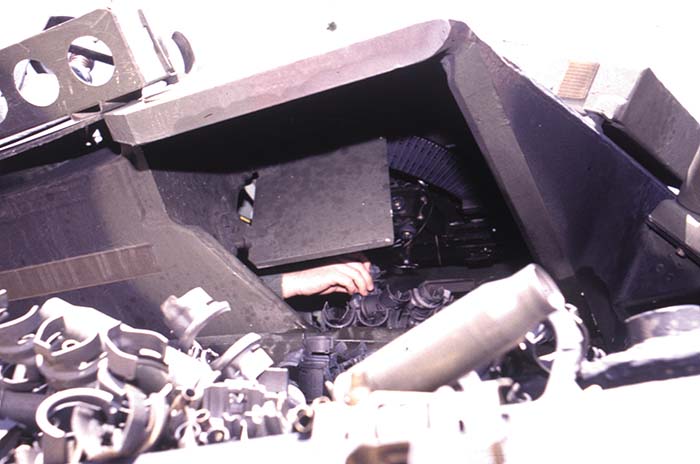
Use of a single barrel means lighter weight, relatively few moving parts, and consistent accuracy. Unlike Gatling system revolving cannon, the Chain Gun’s single fixed barrel is not subject to boresight deviations inherent in multi-barrel clusters, nor to the “lawn sprinkler” effect of tangential velocity as experienced from Gatling pipes spinning at high rate of fire.
A logical alternative to self-cycling designs is provided by the Bradley’s electrical system as a power source. Operated by a small 1.5 horsepower motor, the M242 runs quite smoothly with little recoil-induced vibration. In the unlikely emergency of a total electrical system failure, a hand crank can cycle the gun for a last-ditch shot or clearing.
Damping of the short recoil stroke of the barrel is efficiently accomplished with a sealed unit containing ordinary coil springs.
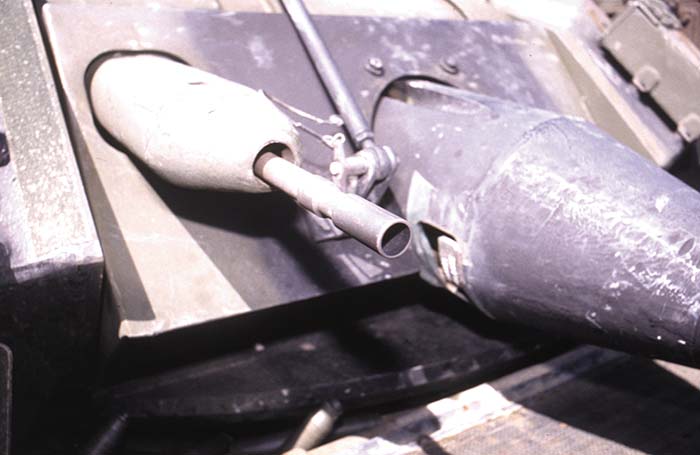
Dual Feed Not Double
Dual feed – its capability to instantly switch over between two types of ammunition – is one of the more useful characteristics of the Chain Gun design. This means that a gunner who is expecting to engage an armored vehicle can immediately change to a high explosive if an appropriate target presents itself.
The Chain Gun’s cycle of operation begins and ends with the bolt fully rearward and no round in the chamber. This eliminates “cookoff,” the possibility of accidental explosion of a round left in an overheated chamber. Similarly, “double feed” – attempt to feed a round when another is still in the chamber – is blocked by a sensing rotor that instantly tops the feed system if a round fails to extract. In addition to avoiding ugly malfunctions, this eliminates the possibility of catastrophic in- turret explosion from jamming the nose fuze on an HE round being fed.
Its deceptively simple mechanism is all the more remarkable for its extraordinary reliability. Not only do published figures cite better than 10,000 mean rounds between stoppage, the gun can also be cleared with speed and safety.
Not surprisingly, the Hughes CHAIN GUN overcame virtually every objectionable aspect of competitive systems and quickly took the lead in the Army’s Vehicle Rapid Fire Weapon System test program. The M242 was formally adopted on 19 February 1973 with the official nickname of BUSHMASTER, the large and deadly poisonous snake of the Central American jungles.
Ultimate Machine Gun Mount
Since the hard-hitting, multi purpose 25mm M242 version weighs over 230 lbs and has an effective range in excess of 3000 meters, the best way to maximize its lethality is to put it in what might be called the ultimate machine gun ground mount.
This is the Bradley Fighting Vehicle, a fully tracked armored weapons platform with a stabilized turret and highly sophisticated day and night sighting systems. Designed to keep up with the M1 Abrams’ main battle tank in the mechanized “AirLand Battle” once envisioned for central Europe, it clearly outclasses its rival, the Soviet BMP armored fighting vehicle.
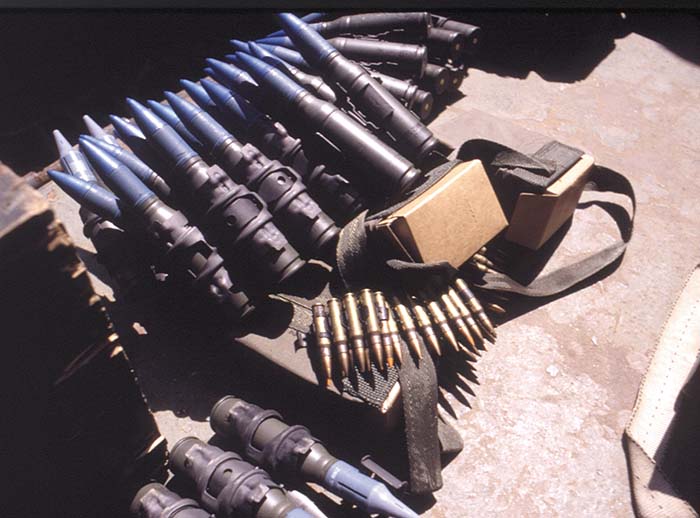
As mounted in the Bradley, the Chain Gun has distinct advantages in mobility and crew protection, allowing the gunner to identify and destroy a wide variety of threats including bunkers, other armored vehicles, and even helicopters. And for those situations when the 25mm isn’t ideal, the Bradley turret also features both a 7.62mm M240 machine gun and a pair of TOW missiles, fully integrated with the vehicle’s fire control system.
Live Fire Gunnery Training
Small Arms Review was invited to examine the Chain Gun in action with the North Carolina National Guard’s 1st Battalion 119th Infantry Regiment (Mechanized). The Tarheel trackmen were up in my neck of the woods at Fort Pickett, Virginia’s Range 13, spending several weekends rotating Bradley crews through the demanding Bradley Table VIII live fire qualification course. This was a perfect opportunity for me to have plenty of time to observe and photograph all aspects of the training without getting too much in their way at a stressful time.
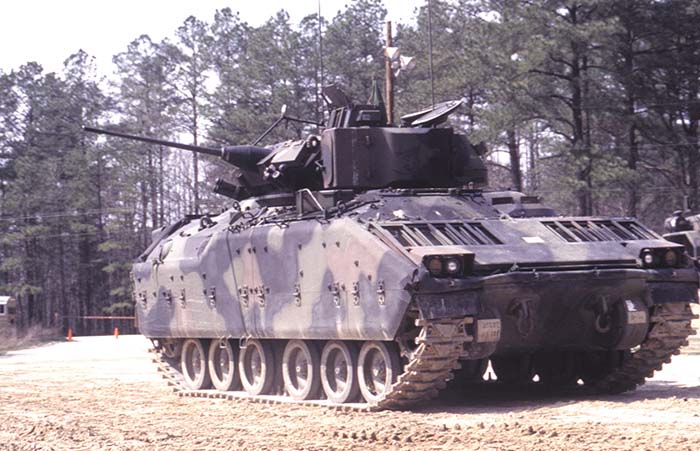
Under command of Major Greg Lusk, this is a great bunch of guys and I found them to be quite serious about maintaining high standards despite the very real problems of today’s budget- starved military. Master Sergeant Tim Davis, battalion training NCO, wisely hooked me up with a Charlie Company Bradley M2 commanded by Sergeant First Class Dannie Lewis. Along with the gunner, Sergeant James Pierce, Lewis and the rest of his crew patiently answered my endless (and often borderline stupid) questions and provided a step-by-step “show and tell” for photographs as they prepared for their turn at bat.
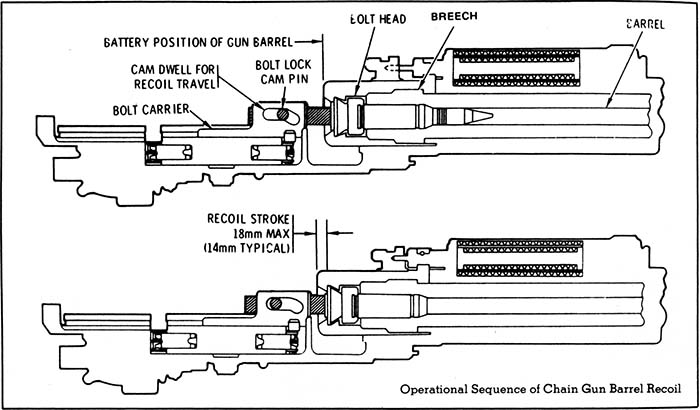
After a thorough before-operation check of all systems and final preparations of both the Chain Gun and the M240 coaxial machine gun, Lewis’ Bradley pulled up next to the big ugly ammo HEMMT. The Army has a standard load formula for this course so they got the prescribed mix of 25mm M910 TPDS-T plus linked 7.62mm in the usual four ball plus one tracer mix. According to Army specifications, the 25mm Target Practice Discarding Sabot- Tracer matches the velocity and trajectory of real combat ammo well beyond 2000 meters with twin advantages of lower cost and an 8000 meter maximum range that won’t exceed the impact area safety fan limits.
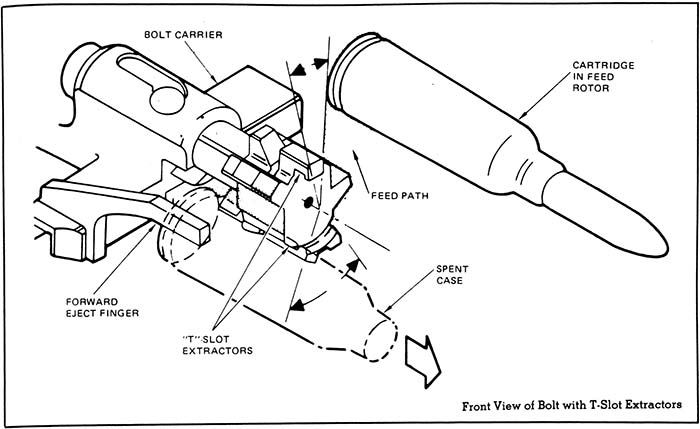
The gunner, Sergeant Pierce, showed me how the linked 25mm is hung in two separate compartments on opposite sides of the turret, ready for feeding as the situation dictates. A simple diagram is thoughtfully provided on each magazine to make sure the bullets are pointed in the right direction; important soldier proofing to help tired and stressed crewmen. For safety purposes the belts weren’t actually fed into the guns at this time. Instead, this final step was not performed until the vehicle was cleared to move onto the range for its trial by fire.
Riding the Range
Wishing them well, I moved up to the main range area for a quick orientation. The sand table was a great place to start, providing a miniature overview of the terrain including firing points and target types. While some might say that this gives an unfair advantage not likely to be experienced in combat, the Army contends that the job of determining baseline gunnery skills should be done in an orderly and standardized manner. Coping with surprise targets on unfamiliar terrain is a higher-level challenge, best done after the crew has proven that it has mastered the basics.
The range control tower was manned by a team of active Army Master Gunners who had been sent to Ft. Pickett to conduct the Guardsmen’s testing. These guys were making sure that each task in the course was fairly presented and impartially graded. Their work was not made easy by the somewhat poor condition of the whole radio-controlled target system. It performed erratically and sometimes just refused to work, giving the unit’s target detail plenty to do downrange with resulting delays. On a positive note, this gave me an unusual opportunity to ride with them and to get a close look at both the stationary and moving target mechanisms in the enormous impact area.
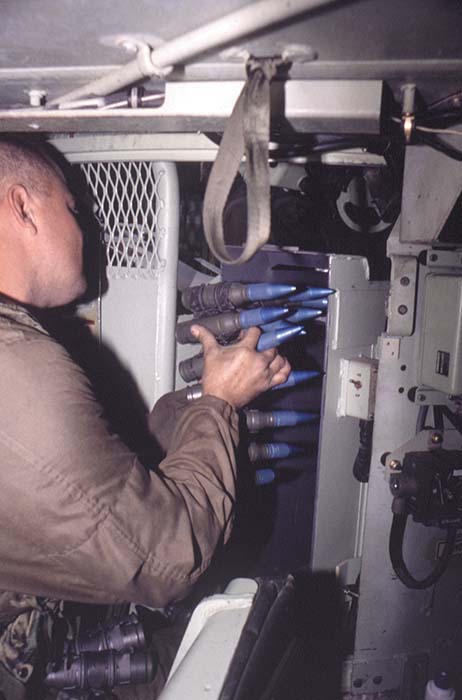
The effects of eight years of miserly military budgets can be seen in a million ways, big and small, throughout the armed forces; in this case worn-out target lifters paired with old and abused electronic controllers. While Bill and Hillary flew around like a king and queen on Air Force jets, muddy-boot soldiers make the best of a bad situation literally with duct tape, and coat hanger wire. Many have to buy batteries themselves.

In the rare situation when everything goes well, the daylight part of the table can be fired by a Bradley crew in about 45 minutes. This includes a substantial amount of time for zeroing and for getting into full chemical gear for Task 6.
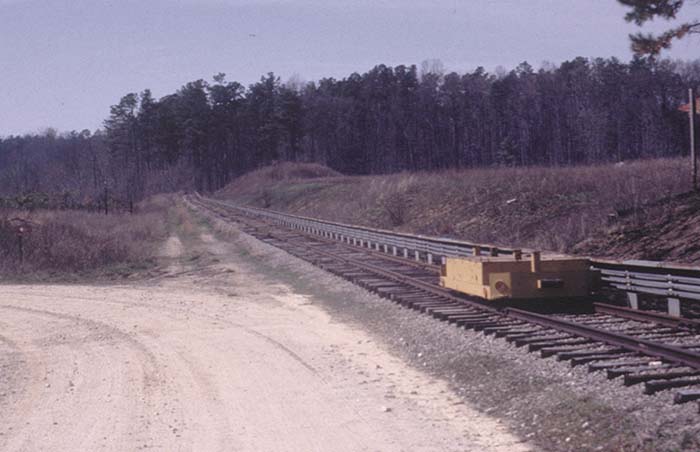
The course begins with the vehicle moving up into the first of two fixed firing points identified on the accompanying map as BP2. This is used to zero both the coaxial machine gun and the Chain Gun by optically sighting clearly identified panels positioned 500 and 1100 meters distant. If the tracers hit the panels then the guns are zeroed, if not then it takes some more time and adjustments to get them working together.
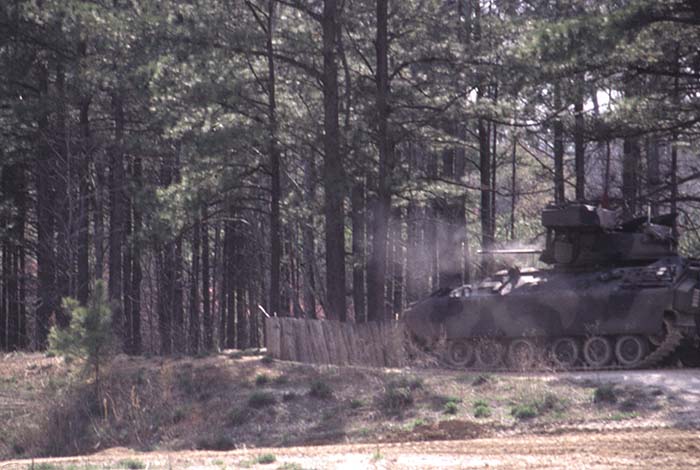
When the vehicle commander and gunner are satisfied with their zero then record firing can begin, escalating in degree of difficulty. From stationary Bradley and fixed targets to shooting at trolley-borne movers while on the run, the course presents many realistic situations likely to be encountered in combat. Bare minimum qualification standards require hits in at least seven engagements including one while wearing a gas mask and two at night.
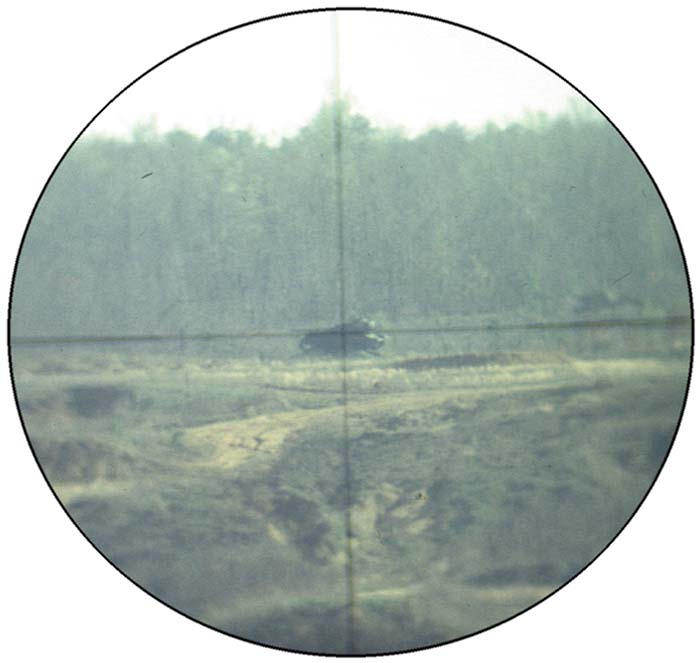
No Excuses
When the crew on the hot seat has finished its run, they download and clear their guns then dismount for an unflinchingly honest evaluation. All of the target action for each Bradley’s range time is recorded on gun camera videotape with an on-screen time code, then played back for the crew by a member of the test team like a real-world video game. Each target presentation scenario can be looked at again and again in real time or in slow motion and even stopped for a detailed analysis.
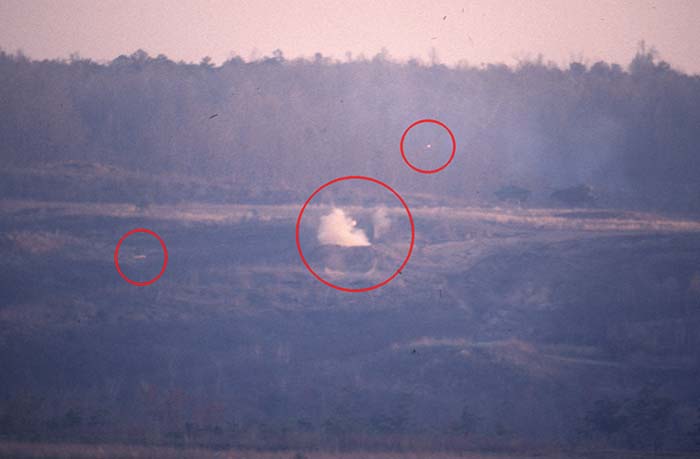
This high-teh After Action Review not only allows the Bradleymen to see what they did right or wrong, it also provides the necessary evidence to challenge any miss-scoring that might have happened in the tower such as not leaving the target up for the minimum required time. More than just a series of dry score sheets, these videos give the unit’s leadership a highly objective view of each crew’s proficiency in target identification, choice of the best weapon (main gun vs. coax) fire commands and marksmanship.
| This article first appeared in Small Arms Review V4N6 (March 2001) |



